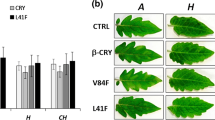Abstract.
Stimulation of plant natural defenses is an important challenge in phytoprotection prospects. In that context, elicitins, which are small proteins secreted by Phytophthora and Pythium species, have been shown to induce a hypersensitive-like reaction in tobacco plants. Moreover, these plants become resistant to their pathogens, and thus this interaction constitutes an excellent model to investigate the signaling pathways leading to plant resistance. However, most plants are not reactive to elicitins, although they possess the functional signaling pathways involved in tobacco responses to elicitin. The understanding of factors involved in this reactivity is needed to develop agronomic applications. In this review, it is proposed that elicitins could interact with regulating cell wall proteins before they reach the plasma membrane. Consequently, the plant reactivity or nonreactivity status could result from the equilibrium reached during this interaction. The possibility of overexpressing the elicitins directly from genomic DNA in Pichia pastoris allows site-directed mutagenesis experiments and structure/function studies. The recent discovery of the sterol carrier activity of elicitins brings a new insight on their molecular activity. This constitutes a crucial property, since the formation of a sterol-elicitin complex is required to trigger the biological responses of tobacco cells and plants. Only the elicitins loaded with a sterol are able to bind to their plasmalemma receptor, which is assumed to be an allosteric calcium channel. Moreover, Phytophthora and Pythium do not synthesize the sterols required for their growth and their fructification, and elicitins may act as shuttles trapping the sterols from the host plants. Sequence analysis of elicitin genes from several Phytophthora species sheds unexpected light on the phylogenetic relationships among the genus, and suggests that the expression of elicitins is under tight regulatory control. Finally, general involvement of these lipid transfer proteins in the biology of Pythiaceae, and in plant defense responses, is discussed. A possible scheme for the coevolution between Phytophthora and tobacco plants is approached.
Similar content being viewed by others
Author information
Authors and Affiliations
Additional information
Received 10 June 1999; received after revision 15 September 1999; accepted 17 September 1999
Rights and permissions
About this article
Cite this article
Ponchet, M., Panabières, F., Milat, ML. et al. Are elicitins cryptograms in plant-Oomycete communications?. CMLS, Cell. Mol. Life Sci. 56, 1020–1047 (1999). https://doi.org/10.1007/s000180050491
Issue Date:
DOI: https://doi.org/10.1007/s000180050491




